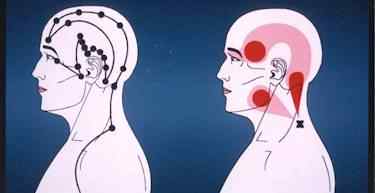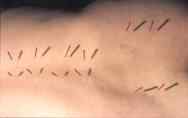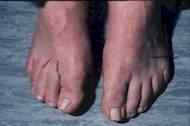Positive Health Online
Your Country

Acupuncture: East Meets West
by Dr Richard Halvorsen(more info)
listed in acupuncture, originally published in issue 44 - September 1999

A diagram illustrating the similarity between the path of the Gall Bladder meridian (left) and the radiation of pain from a trigger point (the cross) in the trapezius muscle.
The Debate
"You don't have any idea what acupuncture really is, do you?' said Zoe with obvious irritation. "You think that by going on a week-end course and learning what sounds to me like trigger point therapy, you can now let yourself loose actually sticking needles in people. It's outrageous." Her voice was becoming louder and higher pitched, the angrier she became. "Don't you realise that acupuncture is a profound and complex system of medicine that has been developed by the Chinese over thousands of years. It requires years of training to begin to understand the traditional Chinese system of medicine, and you just stick a few needles in tender spots and have the cheek to call that acupuncture."
Conditions for which acupuncture is most effective 1. Back pain |
"Hold your horses, girl," replied Jack, who, as a GP, was used to difficult interactions. It was true. He had been on a week-end acupuncture course, and had cautiously been inserting a few needles in some of his patients (as he called them), who had mainly painful conditions, but he had been quite pleased with his limited success so far and was not going to be put off his stride by his irate friend. "Look," he replied, "I may not be practising the sort of acupuncture that you do, but it is still acupuncture which, as far as I understand it, means inserting needles in someone to obtain a beneficial effect. What matters is that it works. And anyway," he felt it was now time to start getting his own back, "I don't need as much training as you because I learned all my anatomy and physiology at medical school. You had a lot of catching up to do before you could start safely sticking needles in patients."
"Clients," insisted Zoe, "we call them clients. You have to medicalise everything don't you? You don't have to be ill to have acupuncture. It can be used to reharmonise the chi before you actually notice anything wrong, but you wouldn't understand that." She was now rising to the bait. Zoe hated it when Jack got on his 'I'm a doctor' high horse. In truth, she was probably more than a little jealous. It was now time, she felt, for the knock-out punch. "Actually," she spoke slowly and determinedly, "all your western physiology has got nothing whatever to do with acupuncture. Those of us who have studied Chinese medicine know that the heart does a whole lot more than just pump blood round the body. It controls the blood vessels, stores the 'Shen' or Spirit, and also opens into the tongue so I can often detect a disharmony in the heart simply by looking at the tongue, such as 'deficient heart yin' or 'mucous fire agitating the heart'."
Jack was beginning to lose the thread of Zoe's argument. "Hang on a minute," he said, "all this oriental mumbo-jumbo is all very well, but how do you know that it actually works? You show me the evidence that you are getting any better results doing your yin and yang thing than I am just inserting needles into tender points." Zoe had been expecting this. Sooner or later, in any discussion (or argument as it would usually turn out) with a so-called western scientific doctor, the subject of 'evidence' would come up. This really got to her, because she knew that, from Jack's viewpoint there was little real 'evidence' that her acupuncture that she had spent years studying, even visiting China for a month three years previously, did actually work better than that awful word – it sent shivers down her spine – placebo. But she was ready for this one.
"The system of medicine that I practise is patient-centred. I might treat six patients, whom you diagnose as all having gallstones, in completely different ways. There is no way that one of your double-blind placebo controlled trials would work in that situation. Anyway, I know it works – I don't have to prove it, and certainly not to the likes of you."
Main Points
|
The above fictitious conversation could have continued for a good deal longer, but still Zoe and Jack would not understand each other. This dialogue illustrates the debate that is now raging in this country between acupuncturists who practise traditional Chinese acupuncture and those who practise western 'scientific' acupuncture. The former are largely, but by no means exclusively, lay acupuncturists who have not had western medical training. They have usually, but not necessarily, undergone relatively lengthy training in Chinese medicine as well as some anatomy and western physiology. They are likely to practise acupuncture as a complete system of medicine – whatever problem you take to them, they will, more often than not, offer you acupuncture treatment. The latter are usually medically qualified and have undergone some further training in acupuncture in order to have an extra therapeutic arrow to their bow. Their acupuncture training, at least initially, may not be more than the odd week-end, but then they are often not interested in learning all about the philosophy or theory of traditional Chinese medicine (TCM). They simply want to practise something that works. And herein lies the crunch: when does acupuncture work and when doesn't it? Does acupuncture practised within the framework of TCM work any better than, or even as well as, 'western scientific' acupuncture based on totally different principles? And where does all this leave the hapless migraine sufferer wondering whom to visit to obtain the best treatment?

Acupuncture needles inserted into points along the back using the principle of segmental acupuncture

Acupuncture needles inserted into acupuncture points Liver 3 in the feet. These are traditional points situated on the Liver meridian
The History
Let us take a step back from the debate at this point to look very briefly at the history of acupuncture. It has been practised in China for several millennia. The first definitive text on acupuncture is considered to be the Huangdi Neijing, compiled between 500 and 300 BC. There are differing theories on when acupuncture was brought to Europe, but probably in the 17th century by Dutch traders. In any event interest in acupuncture only really started to take off in the West in the 1960s. Since acupuncture originated in China and the Far East it was not surprising that most acupuncture initially practised was TCM-based, founded on the ancient principles of yin and yang, energy flow and the five elements.[1] Palpating the pulses at the wrist and looking at the tongue are important diagnostic markers in TCM. Needles are inserted largely into traditional acupuncture points, mainly situated along the body's meridians along which chi or energy is believed to flow. The TCM theory is esoteric and appealing but has precious little evidence to support it. It is, nevertheless, based on many years of clinical experience and observation.
The Questions
Some practitioners in the West have questioned the necessity of practising acupuncture exclusively as traditionally taught. Are there other ways of using it that could be equally or more effective and possibly more appropriate to its use in the West?[2] Trigger point acupuncture involves inserting needles into tender points on the body, often not traditional acupuncture points. This method, however, has always been accepted in TCM which refers to them as Ah Shi points. Periosteal acupuncture involves needling the surface of the bone. Single point acupuncture can be used, for example PC6 on the forearm to treat nausea.[4] Segmental acupuncture is based on the distribution of the nerves and muscles in the body. Others think of 'acupuncture treatment areas', based on most of the above. Other forms of treatment include ear acupuncture which is based on the belief that the whole body is represented in the ear, acupressure and the use of moxibustion – the burning of the herb Artemesia (mugwort) either on a needle or as a cigar shaped stick held over an acupoint. Electricity can be used to stimulate the point either with electrodes attached to needles, or a laser can be used to stimulate the points. Some serious practitioners have even suggested that acupuncture points do not exist – or, looking at it another way, that the whole body is an acupuncture point. This begs the question, 'does it actually matter where the needle is inserted?' The honest answer can only be that, for the most part, we don't know. Additionally, whilst needles are commonly left in the body for around 20 minutes, many 'western' acupuncturists are finding that needling for only a minute or even a few seconds appears to obtain at least as good, if not better, results.
The Evidence
The bottom line is that convincing scientific evidence that acupuncture of any type works is limited. That is not the same as saying that there is evidence that acupuncture doesn't work. In fact there are a few conditions for which the evidence for the efficacy of acupuncture is strong, namely back pain,3 nausea and vomiting,[4] pain in osteoarthritis[5],[6],[7] and turning breech babies in pregnancy,[8] though the last example involves moxibustion. Clinical experience, supported by limited research, suggests that acupuncture can help many more conditions but it would be misleading to say that we have good evidence for this. This lack of hard evidence is one reason for the many claims and counter-claims for acupuncture that abound, most of which should be heard with an open, but healthily sceptical, mind.
What we do know, however, is that, in experienced hands acupuncture is remarkably safe,[9] far safer than the majority of western drugs used so prolifically.[10] Serious side-effects, such as a punctured lung, are extremely rare, and the transmission of infections such as hepatitis or HIV is impossible if disposable sterile needles are used, as is now common practice in the West. The Hippocratic maxim 'first do no harm' springs to mind.
As for the argument at the start of this article, I feel it has to be said that there is no evidence at present that any one form of acupuncture is better or worse than any other. All practitioners, whether medically qualified or not, will be practising in good faith, a method they believe works – for them. If the idea of ancient Chinese wisdom appeals then a practitioner who uses the TCM approach should be sought, and this includes some doctors. If 'evidence-based' acupuncture is being sought, which may well incorporate some TCM where there is supporting research, it may be more appropriate to consult a practitioner practising western scientific acupuncture. But from the point of view of safety, it is important that the acupuncturist is either medically qualified or has had proper training in anatomy as well as acupuncture (see below).
The Future
Acupuncture is at an interesting point in its development in the West. Though the traditional theories sit uncomfortably with orthodox western medicine, an increasing number of medical doctors are incorporating acupuncture into their practice. There is more demand for complementary therapies as western medicine fails to live up to its (or the media's?) promise of a cure for every ill. I believe that the antagonism between medically qualified and lay acupuncturists and the argument about what method of acupuncture to use needs to be channelled into a common approach in which we join forces to provide effective acupuncture for those who will benefit most. The issue of safety is paramount and it may be that some form of regulation should be put into place to ensure that the acupuncturists are adequately trained in safety, not only to ensure that the treatment itself does no harm but also to ensure that the practitioners do not attempt to treat a condition with acupuncture that would be more appropriately and effectively treated with a different approach. The important issue is not the theoretical basis of any one acupuncture method, but whether it actually works or not. Continuing research over the coming years will help to point us in the right direction.
References:
1 Essentials of Chinese Acupuncture, Foreign Languages Press, Beijing.
2 Medical Acupuncture – a Western Scientific Approach, ed. Filshie & White, Churchill Livingstone 1998.
3 Ernst E and White AR. Acupuncture for back pain, A Meta-Analysis of Randomized Controlled Trials. Archives of Internal Medicine 1998; 9: 2235-2241.
4 Vickers AJ. Can acupuncture have specific effects on health? A systematic review of acupuncture antiemesis trials. Journal of the Royal Society of Medicine 1996; 89: 303-311.
5 Christiensen BV, Iuhl IU, Vilbek H, et al. Acupuncture treatment of severe knee osteoarthrosis: A long-term study. Acta Anaesthesiologica Scandinavia 1992; 36: 519-525.
6 McIndoe AK, Young K, Bone ME. A comparison of acupuncture with intra-articular steroid injection as analgesia for osteoarthritis of the hip. Acupuncture in Medicine 1995; 13: 67-70.
7 Tokeda W, Wessel J. Acupuncture for the treatment of pain of osteoarthritic knees. Arthritis Care and research 1994; 7: 118-122.
8 Cardini F, Weixin H. Moxibustion for Correction of Breech Presentation – A Randomized Controlled Trial. The Journal of the American Medical Association 1998; 280: 1580-1584.
9 Norheim A. Adverse effects of acupuncture: a study of the literature for the years 1981-1994. Journal of Alternative and Complementary Medicine 1996: 2(2): 291-297.
10 Lytle C. Safety and regulation of acupuncture needles and other devices. Paper presented at the Consensus Development Conference on Acupuncture, 1997.
Further Information
The British Medical Acupuncture Society (BMAS) was founded in 1980 as an association of medical practitioners interested in acupuncture. There are now 1600 members who use acupuncture in NHS general practice, hospital or private practice.
The BMAS opposes unfounded therapeutic claims and recommends the practice of acupuncture by healthcare professionals. The BMAS supports clinical research into when and how acupuncture works. The BMAS offers doctors comprehensive training in acupuncture, incorporating all the methods described above.
Details of medically qualified acupuncturists can be obtained from: The British Medical Acupuncture Society, Newton House, Newton Lane, Whitley, Warrington, Cheshire, WA4 4JA. Tel: 01925-730727, Fax: -730492, Email:Bmasadmin@aol.com Website:http://www.medical-acupuncture.co.uk
Details of qualified practitioners of traditional acupuncture can be obtained from: The British Acupuncture Council, Park House, 206-208 Latimer Road, London W10 6RE Tel: 020 8735 0400.
Comments:
-
No Article Comments available